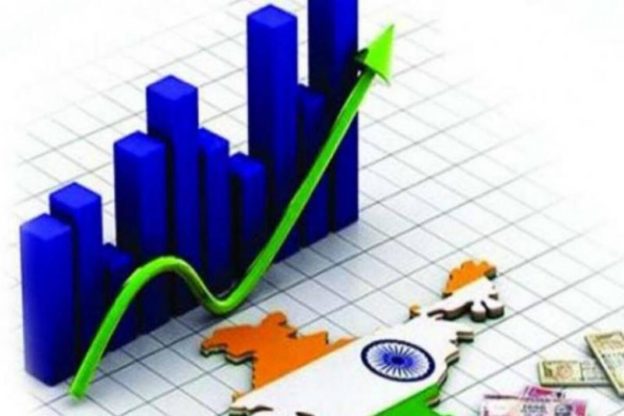Aided by a favourable base and some sequential momentum in services and utilities, India’s gross domestic product (GDP) grew by 13.5% in the June quarter (Q1FY23), according to data released by the National Statistics Office (NSO) on Wednesday.
The headline growth figure, a four-quarter high, was closer to the lower band of the 12-17% range forecast by analysts and much lower than 16.2% predicted by the Monetary Policy Committee.
Compared with the GDP in the corresponding quarter three years ago (Q1FY20), which represented the pre-pandemic period, the GDP in Q1FY23 was just 3.8% higher.
The economy will likely see slower growth in the current quarter and the coming few quarters, due to a waning of the base effect and a slowing of exports. The external headwinds also could hit private capex plans.
Finance secretary TV Somanathan said the Q1 data are in sync with the government’s expectations that GDP growth for the full year would be in the 7-7.5% range.
The NSO data showed a pick-up in contact-intensive services post the Omicron wave, continued government support to the economy by way of robust capital expenditure and a moderate revival of private consumption. It also reflected strong corporate earnings, but a steady improvement in industrial capacity utilisation over several quarters was yet to meaningfully translate into fresh corporate investments.
To be sure, both private consumption expenditure and gross fixed capital formation posted strong year-on-year expansion in June quarter at 25.9% and 20.1% respectively and increased their shares in GDP. However, both these demand components saw marginal sequential declines. The uptick in investments was primarily driven by public capital spending.
The growth in gross value added (GVA) in agriculture was the sharpest in nine quarters at 4.5%, while the overall GVA growth was 12.7%.
Also Read: Centre reports fiscal surplus in July, first in over two years
Though cyclical tailwinds and release of pent-up demand seemed to support the economy in the June quarter, the revival was yet to be fully broad-based. The manufacturing GVA grew at a lower-than-expected rate of 4.8% and the GVA in ‘trade, hotels, transport and communications etc’ was still 15.5% lower than the pre-pandemic level (Q1FY20).
Also, sequential declines in size were reported by several sectors including construction, ‘public administration, defence and other services’, besides the manufacturing and ‘trade, hotels..’ segments. Government’s final consumption expenditure also declined sequentially, reflecting regulation of revenue spending.
Though improving bank credit, higher capacity utilsation and the perceived benefits from global supply chain diversification are seen to support domestic demand in the short term, the dip in external demand and rising interest rates could offset these gains.
Some high frequency indicators are already a pointing to a loss of momentum since June. Data released separately showed that the growth in output of eight core infrastructure sectors slowed to 4.5% in July — the lowest in six months — against 13.2% in June and 9.9% in the year-ago period.
Moreover, according to the Controller General of Accounts (CGA) data released on Wednesday, while the Centre’s budgetary capital expenditure was up 62% on year in April-July, the larger revenue expenditure grew by a lower-than-budgeted rate of 5%. Though capital expenditure by Central Public Sector Enterprises has done well so far in FY23, states’ spending on new asset creation has slowed.
Nominal GDP, on which key Budget numbers are benchmarked, jumped as much as 26.7% in the first quarter of FY23 to `64.95 trillion, reflecting elevated inflationary pressure and base effect. It will help inflate the base for the calculation of FY23 fiscal deficit, especially if inflation continues to remain high in the coming quarters.
The pull-down impact of net exports remained high in the June quarter. While exports registered decent growth in Q1, imports rose at a scorching pace, inflating the trade deficit to the record level. The share of exports in GDP (in real term) rose to 22.5% in the June quarter from 22% a year ago, that of imports spiked to 27.8% from 22.6% a year earlier.
Crisil chief economist DK Joshi said: “First-quarter GDP growth came in lower than expected. High net imports and weaker government consumption expenditure kept overall growth soft. Private consumption is improving, with urban demand getting support from contact-intensive services. Had it not been for high inflation and subdued rural demand due to negative real rural wage growth, private consumption would have grown faster.”
Aurodeep Nandi, India economist at Nomura, said: “Post-pandemic tailwinds essentially lifted the GDP in Q1FY23 – even if we were to discount the low base, this marks a stellar rise in sequential momentum. This marks a confluence of tailwinds, such as the catch-up in contact-intensive services, public capex push, and lagged impact of easy financial conditions.”
https://www.financialexpress.com/economy/first-quarter-growth-at-13-5-on-a-low-base/2651255/





